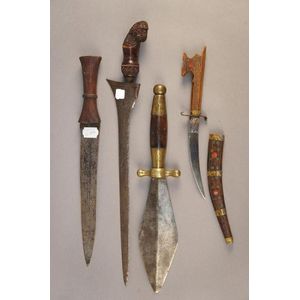19th Century Indian Kard with Silver Scabbard
High quality mid 19th century Indian kard with scabbard, originally part of the armoury of Badhanware, approx 35 cm overall with approx 25 cm blade of the finest watered steel of the Mohammed's ladder pattern. The ricasso and tang with fine gold koftgari floral decoration, ivory grip scales with silver rosettes. The scabbard of silver finely pierced with floral motifs. With its original woven retaining cord and red cloth storage bag.
You must be a subscriber, and be logged in to view price and dealer details.
Subscribe Now to view actual auction price for this item
When you subscribe, you have the option of setting the currency in which to display prices to $Au, $US, $NZ or Stg.
This item has been sold, and the description, image and price are for reference purposes only.
- Ivory - Ivory is a hard white material that comes from the tusks of elephants, mammoth, walrus and boar, or from the teeth of hippopotamus and whales. The ivory from the African elephant is the most prized source of ivory. Although the mammoth is extinct, tusks are still being unearthed in Russia and offered for sale.
Ivory has been used since the earliest times as a material for sculpture of small items, both in Europe and the east, principally China and Japan.
In Asia ivory has been carved for netsuke, seals, okimono, card cases, fan supports, animals and other figures and even as carved tusks.
In the last 200 years in Europe ivory has been used to carve figures, for elaborate tankards, snuff boxes, cane handles, embroidery and sewing accessories, in jewellery and as inlay on furniture. Its more practical uses include being used for billiard balls, buttons, and a veneers on the top of piano keys.
The use and trade of elephant ivory have become controversial because they have contributed to Due to the decline in elephant populations because of the trade in ivory, the Asian elephant was placed on Appendix One of the Convention on International Trade in Endangered Species (CITES), in 1975, and in January 1990, the African elephant was similarly listed. Under Appendix One, international trade in Asian or African elephant ivory between member countries is forbidden. Unlike trade in elephant tusks, trade in mammoth tusks is legal.
Since the invention of plastics, there have been many attempts to create an artificial ivory
This item has been included into following indexes:
Visually similar items

A World War II German Mauser bayonet & sheath blade 24 cm
Sold by
in
for
You can display prices in $Au, $US, $NZ or Stg.

British / Australian P1907 bayonet and scabbard. Dated 1915
Sold by
in
for
You can display prices in $Au, $US, $NZ or Stg.

A important and rare north Indian pesh kabz of late 18th century date and of Museum quality, approx 44 cm overall with 31 cm blade. The blade of finest watered steel is of very pronounced T section with the back being 13 mm in width at the base, the whole
Sold by
in
for
You can display prices in $Au, $US, $NZ or Stg.

Four North African daggers (4)
Sold by
in
for
You can display prices in $Au, $US, $NZ or Stg.
